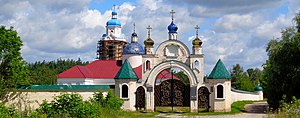Mykola Krupytskyi Monastery
| Saint Nicholas Krupytskyi Monastery/Миколаївський Крупицький монастир | |
|---|---|
 View of the Saint Nicholas Krupytskyi Monastery | |
| Religion | |
| Affiliation | Ukrainian Orthodox Church (Moscow Patriarchate) |
| Location | |
| Location | Nizhyn Raion, Chernihiv Oblast, Ukraine |
| Architecture | |
| Architectural style | Ukrainian Baroque |
Saint Nicholas Krupytskyi Monastery (Ukrainian: Миколаївський Крупицький монастир, romanized: Mykolaivskyi Krupytskyi monastyr) is an orthodox monastery, classified as a monument of architecture and urban planning of the 17-19th centuries. It is located in the village of Verbivka, Nizhyn Raion, Chernihiv Oblast, Ukraine. It is a part of the National Historical and Cultural Reserve "Hetman's Capital", and located 10 kilometres (6 mi) from Baturyn, a seventeenth and eighteenth-century capital of the Cossack Hetmanate.
Legends of the monastery[edit]
The monastery was probably founded in the pre-Mongol period on the site where the icon of St. Nicholas appeared. During the Mongol invasion, monks and people living near the monastery hid behind its strong walls and weathered the siege until they ran out of food and were threatened with starvation. Then, according to a legend recorded by the abbot of the monastery Dimitry of Rostov, by God's will, cereals fell from the sky, which saved the defenders from starvation. This event was reflected in the second name Krupytskyi (after cereals). Wonderful cereals, in memory of the great miracle, were kept in the monastery in a silver ark until the time of Hetman Ivan Mazepa. However, despite the miracle, the monastery was still destroyed in the 13th century.[1]
History of the monastery[edit]

Foundation[edit]
The monastery was restored at the beginning of 16th century by nun Mokrina. Since then, it was gradually developed, in particular at the expense of lands and villages assigned to it by Hetmans Bohdan Khmelnytsky, Yurii Khmelnytsky, Demian Ignatovych (Mnohohrishny), Ivan Samoylovych and Ivan Mazepa.
After Baturyn was proclaimed the residence of the hetmans in 1669, the monastery became one of the main centers of cultural and religious life in the Cossack Hetmanate, as well as a well-fortified fortress surrounded by ramparts with wooden walls and towers.
In 1680, in the best traditions of the Ukrainian Baroque, a five-nave church of St. Nicholas was built at the expense of General Judge Ivan Domontovych. In its iconostasis was placed the main shrine: the icon of St. Nicholas of Myra. The temple was destroyed in the 1930s.
Many famous cultural figures of the Hetmanate connected their lives or activities with the monastery. Its most famous abbot was the religious figure and writer Dmytro Tuptalo (canonized in 1757 as Saint Dmitry of Rostov), who continued here his work on the hagiographic work "Cheti-Minei", which made him famous in the Orthodox world. In 1691 he moved to the monastery (with the assistance of Ivan Mazepa) a part of the relics of the Great Martyr Barbara that were previously stored in Baturyn.
During the Great Northern War, after the destruction of Baturyn in November 1708, Russian troops led by Alexander Menshikov also destroyed and looted the monastery. It resumed its activities gradually in the 18th century.[2]
The monastery had a library. One of its most valuable items was a 1581 Ostroh Bible. A significant number of its Polish-language books were lost in the 18th century, and some Latin ones in the 19th century transferred to the library of St. Sophia Cathedral in Kyiv. Much of the library and the unique archive containing the original documents, such as Hetman's universals and royal charters for possession of property and lands, manuscripts on the history of the monastery, etc., were destroyed in the 1920s.
The military engineer and architect Adam Zernikaw is buried in the cemetery of the monastery (where, according to legend, the appearance of a Miraculous Image of St. Nicholas took place). Judge General Ivan Domontovych and the last Archimandrite of the Zaporizhian Sich Sich Volodymyr Sokalskyi are buried in the brick church of St. Nicholas.
Closure and decline[edit]
The monastery ceased operations after the establishment of Soviet rule in 1922. Its premises were repeatedly rebuilt, and suffered significant damage during World War II.[3]
Post–independence[edit]
Preserved to this day are the warm refectory of the Church of the Transfiguration (Ukrainian: Спасо-Преображенська церква, romanized: Spaso-Preobrazhenska tserkva, 1803), the bell tower (1825), and monastic cells (abbot's house, 1834).
In 1996, they were included in the National Historical and Cultural Reserve "Hetman's Capital".
In 2000, archeological research of the territory of the monastery was carried out by the Baturyn Archeological Expedition.
A nunnery has been operating here since 1999. Since then, restoration and construction work has begun in the monastery.[4]
References[edit]
- ↑ "Крупицкий Батуринский Третье-классный мужеский монастырь Св. Николая". Черниговские епархиальные известия: 1–43. 1862.
- ↑ Kiiashko L. Mainovyi stan Baturynskoho Mykolaivskoho Krupytskoho monastyria v XVIII st.
- ↑ Baturyn
- ↑ Vechersʹkyĭ, Viktor (2008). Hetʹmansʹki stolyt︠s︡i Ukraïny. Kyïv: Nash chas. ISBN 978-966-8174-91-9. OCLC 221534924. Search this book on

This article "Mykola Krupytskyi Monastery" is from Wikipedia. The list of its authors can be seen in its historical and/or the page Edithistory:Mykola Krupytskyi Monastery. Articles copied from Draft Namespace on Wikipedia could be seen on the Draft Namespace of Wikipedia and not main one.
